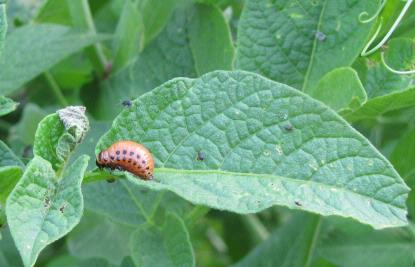 According to “Colours of conflict” an article on The Economist’s website, the pro-Russian rebels in Ukraine wear a multicolor ribbon to show their loyalty to Russia. They show the colors of the Order of St. George: orange and black. The Ukrainian loyalists have taken to calling folks who wear these ribbons “Koloradskiye zhuki” or Colorado beetles. That might seem a quirky mildly offensive nickname, but to anyone who grows potatoes (Ukraine is fourth behind China, India and Russia according to the UN food and agricultural organization), these orange and black beetles are much more than mildly offensive.
According to “Colours of conflict” an article on The Economist’s website, the pro-Russian rebels in Ukraine wear a multicolor ribbon to show their loyalty to Russia. They show the colors of the Order of St. George: orange and black. The Ukrainian loyalists have taken to calling folks who wear these ribbons “Koloradskiye zhuki” or Colorado beetles. That might seem a quirky mildly offensive nickname, but to anyone who grows potatoes (Ukraine is fourth behind China, India and Russia according to the UN food and agricultural organization), these orange and black beetles are much more than mildly offensive.
They’re stinking foul little monsters can defoliate your potatoes when you turn your back to scold a child for chasing chickens or attempting to throwing bricks at his brother. They seemed to appeared quite suddenly a few days ago. I rounded the end of my pea plot during weeding, and there stood a beautiful row of potatoes with dozens of the little Russian separatists.
Clearly picking off eggs had failed. Of course a single female can lay 800 eggs during her adulthood and she lays them in little clutches of twenty or thirty. So you don’t need to miss a lot to get a lot of leaf munchers. And the little bastards start out so small (I have it on good authority that the vast majority of beetle mothers are unwed). But just like the boarders they grow quickly. They pass through four instars each lasting half a week or so depending on temperature.
When they first hatch the wee larva hang out by the empty eggs eating what’s nearby, but as they grow they spread out. My infestation seems to be pretty localized, so I’m guessing I missed a couple of egg clusters in particular spots. The final larva, after doing the most damage, crawls off the potato, burrows into the soil and pupates (just like a butterfly) then emerges as an adult a few weeks later or hangs out until spring to unleash their mandibles on another crop. What an empty and shallow life they lead.
The Colorado potato beetle started out as an unknown mischief maker on buffalo burr, a nightshade family plant of the west. There weren’t a lot of these and nobody really cared if they got eaten so the beetles weren’t really noticed until 1859 when people started growing a lot of potatoes near the buffalo bur in Nebraska. Seeing an opportunity, the beetle jumped ship, so to speak. Fifteen years later it had followed the potato road all the way to the east coast. Now even the Ukrainians recognized them.
One of the coolest, or most infuriating, aspects of the CPB (not the corporation for public broadcasting mind you) is that it quickly becomes resistant to insecticides. According to Llyokhin et al in the 2008 issue of the American Journal of Potato Research, the CPB has become resistant to 52 different insecticides from all the major classes, including DDT. Most insects don’t do this, the CPB is good at it.
So what does this mean? It’s a harder question than one might think. An organism does not begin to evolve a resistance because of the presence of the chemical. Changes in traits happen because of random mutations in the organism’s DNA over stretches of time, not IN RESPONSE to the environment. Most of the time this means that the resistance was already present at some low level in the population (sure sometimes a lucky mutation might happen, but the rapidity with which CPB populations have become resistant to insecticides belies this). The use of insecticides wiped out the insects with low resistance. The survivors had more offspring that carried the resistance trait and soon the whole population is resistant.
So we’ve got an armored little leaf eating monster that laughs at our chemicals. Good thing crushing them still works. Evolve your way out of that you little pro-Putin monsters.


